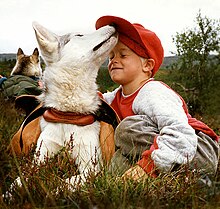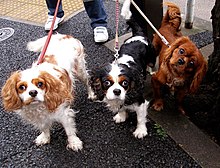The Domestic Dog - 3





The Domestic Dog - 3
As pets
Siberian Husky—pack animal
Couple sitting on the lawn with a pet British Bulldog
A British Bulldog shares a day at the park.
Green velvet dog collar, dates from 1670 to 1690.
The latest study using magnetic resonance imaging (MRI) comparing humans and dogs showed that dogs have same response to voices and use the same parts of the brain as humans do. This gives dogs the ability to recognize emotional human sounds, making them friendly social pets to humans. According to statistics published by the American Pet Products Manufacturers Association in the National Pet Owner Survey in 2009–2010, it is estimated there are 77.5 million people with pet dogs in the United States. The same survey shows nearly 40% of American households own at least one dog, of which 67% own just one dog, 25% two dogs and nearly 9% more than two dogs.
There does not seem to be any gender preference among dogs as pets, as the statistical data reveal an equal number of female and male dog pets. Yet, although several programs are ongoing to promote pet adoption, less than a fifth of the owned dogs come from a shelter.Increasingly, human family members are engaging in activities centered on the perceived needs and interests of the dog, or in which the dog is an integral partner, such as dog dancing and dog yoga.The majority of contemporary people with dogs describe their pet as part of the family, although some ambivalence about the relationship is evident in the popular reconceptualization of the dog–human family as a pack. A dominance model of dog–human relationships has been promoted by some dog trainers, such as on the television program Dog Whisperer.
However it has been disputed that "trying to achieve status" is characteristic of dog–human interactions. Pet dogs play an active role in family life; for example, a study of conversations in dog–human families showed how family members use the dog as a resource, talking to the dog, or talking through the dog, to mediate their interactions with each other. There are a vast range of commodity forms available to transform a pet dog into an ideal companion. The list of goods, services and places available is enormous: from dog perfumes, couture, furniture and housing, to dog groomers, therapists, trainers and caretakers, dog cafes, spas, parks and beaches, and dog hotels, airlines and cemeteries.
While dog training as an organized activity can be traced back to the 18th century, in the last decades of the 20th century it became a high-profile issue as many normal dog behaviors such as barking, jumping up, digging, rolling in dung, fighting, and urine marking (which dogs do to establish territory through scent), became increasingly incompatible with the new role of a pet dog. Dog training books, classes and television programs proliferated as the process of commodifying the pet dog continued. There have been two major trends in the changing status of pet dogs.
The first has been the 'commodification' of the dog, shaping it to conform to human expectations of personality and behaviour. The second has been the broadening of the concept of the family and the home to include dogs-as-dogs within everyday routines and practices. "The most widespread form of interspecies bonding occurs between humans and dogs" and the keeping of dogs as companions, particularly by elites, has a long history. (As a possible example, at the Natufian culture site of Ain Mallaha in Israel, dated to 12,000 BC, the remains of an elderly human and a four-to-five-month-old puppy were found buried together). However, pet dog populations grew significantly after World War II as suburbanization increased.
In the 1950s and 1960s, dogs were kept outside more often than they tend to be today (using the expression "in the doghouse" to describe exclusion from the group signifies the distance between the doghouse and the home) and were still primarily functional, acting as a guard, children's playmate, or walking companion. From the 1980s, there have been changes in the role of the pet dog, such as the increased role of dogs in the emotional support of their human guardians. People and dogs have become increasingly integrated and implicated in each other's lives, to the point where pet dogs actively shape the way a family and home are experienced. It is estimated that three-quarters of the world's dog population lives in the developing world as feral, village, or community dogs, with pet dogs uncommon.
There have been two major trends in the changing status of pet dogs. The first has been the 'commodification' of the dog, shaping it to conform to human expectations of personality and behaviour. The second has been the broadening of the concept of the family and the home to include dogs-as-dogs within everyday routines and practices.
The latest study using magnetic resonance imaging (MRI) comparing humans and dogs showed that dogs have same response to voices and use the same parts of the brain as humans do. This gives dogs the ability to recognize emotional human sounds, making them friendly social pets to humans. According to statistics published by the American Pet Products Manufacturers Association in the National Pet Owner Survey in 2009–2010, it is estimated there are 77.5 million people with pet dogs in the United States. The same survey shows nearly 40% of American households own at least one dog, of which 67% own just one dog, 25% two dogs and nearly 9% more than two dogs. There does not seem to be any gender preference among dogs as pets, as the statistical data reveal an equal number of female and male dog pets.
Yet, although several programs are ongoing to promote pet adoption, less than a fifth of the owned dogs come from a shelter.Increasingly, human family members are engaging in activities centered on the perceived needs and interests of the dog, or in which the dog is an integral partner, such as dog dancing and dog yoga. The majority of contemporary people with dogs describe their pet as part of the family, although some ambivalence about the relationship is evident in the popular reconceptualization of the dog–human family as a pack. A dominance model of dog–human relationships has been promoted by some dog trainers, such as on the television program Dog Whisperer. However it has been disputed that "trying to achieve status" is characteristic of dog–human interactions.
Pet dogs play an active role in family life; for example, a study of conversations in dog–human families showed how family members use the dog as a resource, talking to the dog, or talking through the dog, to mediate their interactions with each other. There are a vast range of commodity forms available to transform a pet dog into an ideal companion. The list of goods, services and places available is enormous: from dog perfumes, couture, furniture and housing, to dog groomers, therapists, trainers and caretakers, dog cafes, spas, parks and beaches, and dog hotels, airlines and cemeteries.
While dog training as an organized activity can be traced back to the 18th century, in the last decades of the 20th century it became a high-profile issue as many normal dog behaviors such as barking, jumping up, digging, rolling in dung, fighting, and urine marking (which dogs do to establish territory through scent), became increasingly incompatible with the new role of a pet dog. Dog training books, classes and television programs proliferated as the process of commodifying the pet dog continued.
|
|
 |
Work
Dogs have lived and worked with humans in so many roles that they have earned the unique nickname, "man's best friend", a phrase used in other languages as well. They have been bred for herding livestock, hunting (e.g. pointers and hounds), rodent control, guarding, helping fishermen with nets, detection dogs, and pulling loads, in addition to their roles as companions. In 1957, a husky-terrier mix named Laika became the first animal to orbit the Earth.
Service dogs such as guide dogs, utility dogs, assistance dogs, hearing dogs, and psychological therapy dogs provide assistance to individuals with physical or mental disabilities. Some dogs owned by epileptics have been shown to alert their handler when the handler shows signs of an impending seizure, sometimes well in advance of onset, allowing the guardian to seek safety, medication, or medical care.
Dogs included in human activities in terms of helping out humans are usually called working dogs.
Sports and shows
Dogs come in a range of sizes.
People often enter their dogs in competitions such as breed-conformation shows or sports, including racing, sledding and agility competitions.
In conformation shows, also referred to as breed shows, a judge familiar with the specific dog breed evaluates individual purebred dogs for conformity with their established breed type as described in the breed standard. As the breed standard only deals with the externally observable qualities of the dog (such as appearance, movement, and temperament), separately tested qualities (such as ability or health) are not part of the judging in conformation shows.
Reference: Wikipedia



 How to resolve AdBlock issue?
How to resolve AdBlock issue?